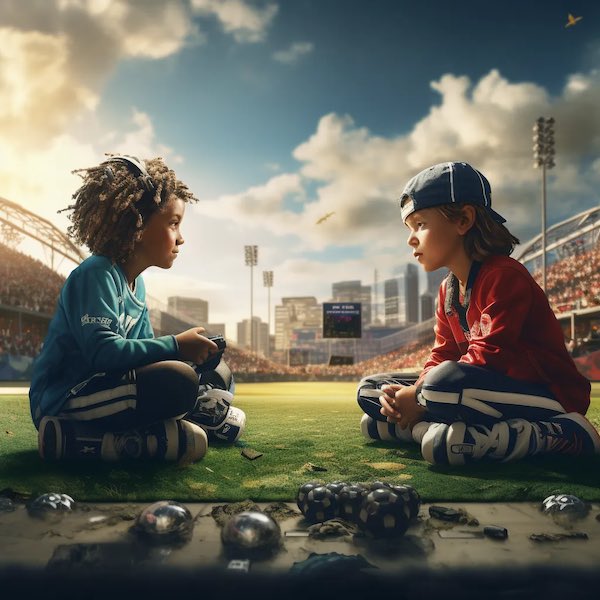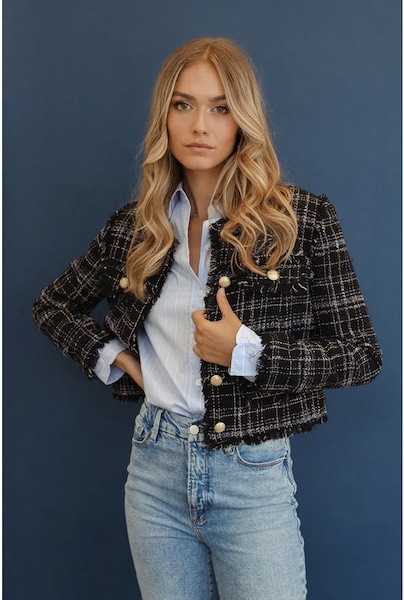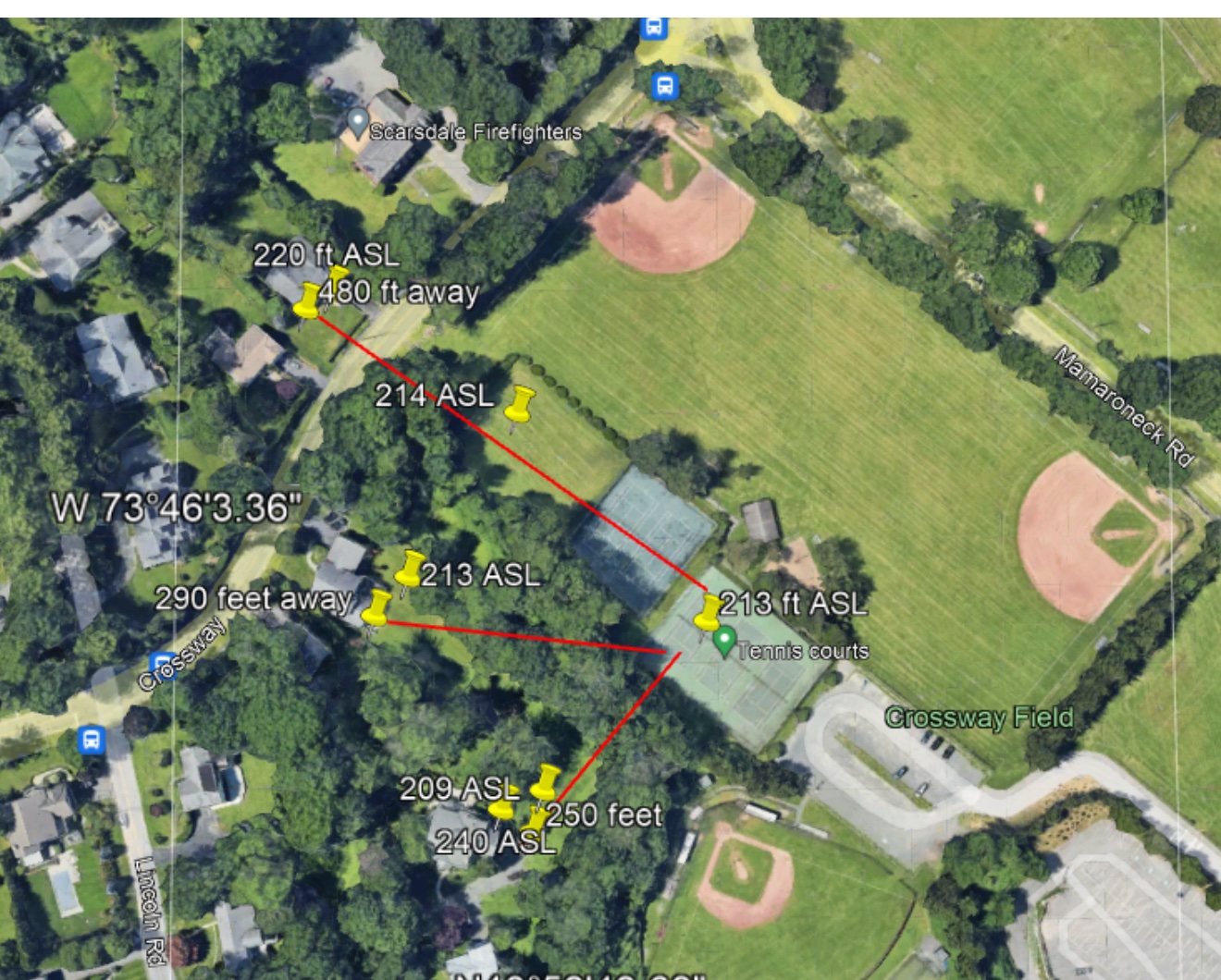Are Kids Playing Enough Sports?
- Details
- Written by Sameer Ahuja
- Hits: 1095
 (Submitted by Scarsdale Village Trustee Sameer Ahuja)
(Submitted by Scarsdale Village Trustee Sameer Ahuja)
“Wait kids, whoever said you had to be good to play football? You play football because you want to. You play football because it’s fun. You play football so you can go out there and pretend you’re Joe Montana throwing a touchdown pass, or Emmett Smith going for a long run. And even if those Cowboys are better than you guys. Even if they beat you 99 times out of 100 that still leaves… one time.”
~Little Giants (1994)
Have you seen the 90’s classic, Little Giants? I’m reminded of it (and its 2000s copycat Kicking and Screaming) when it comes to youth sports.
Here’s a quick recap of the plot: Danny O’Shea (Rick Moranis) is a gas station manager living in the shadow of older brother Kevin (Ed O’Neill) a coach for the local youth football team. Trouble arises when Kevin's team turns down Danny's daughter Becky (Shawna Waldron) because she’s a girl. Danny creates a competing team though the town can realistically support just one. To prove his worth against his brother, Danny coaches his misfits in a crucial playoff.
This film emphasizes how success isn't solely determined by winning. After all, sports are supposed to be fun!
Not only are youth sports a joy to many, but they also provide untold benefits like teamwork and time management skills. Student-athletes must learn to manage school, practices, travel, homework, a job, and more. In many cases, their schedules can become more complex than those of some adults.
Despite so many positives, it seems as if sports have lost some of its spark in recent years. The very fun (Little Giants evokes) appears to have vanished to an extent.
What’s to blame for this turn of events?
Until lately, the pandemic was to blame. Stuck at home, youngsters missed entire seasons after years of hard work. In fact, according to a study by Project Play, kids spent 60% less time playing sports during COVID-19.
But while youth sports definitely took a hit in the past two years, there’s also been a steady decline for at least a decade now—long before social distancing was ever a thing.
So why are kids hanging up the cleats? First off, youth sports have become prohibitively expensive for some. This can create a rift between the haves and have-nots. Meanwhile, community sports programs shuttered in recent years, as they simply can’t compete with increasingly prestigious travel leagues. (This is partly due to how excelling in marquee level sports can earn young people coveted college scholarships.)
When I was growing up, college was more affordable. Many kids didn’t go to school on a sports scholarship or even seek this option. Now with so many higher entry barriers, some parents see sports as a golden ticket to higher education. No longer are good grades and high SAT scores enough. Now, their kids feel pressure to supplement these with sports achievements.
This development may expose another problem: pressure. In a hilarious tryout scene, one dad from Little Giants, describes his over-muscled son, “Won the eight-year-old division of the pass, punt, and run when he was five years old.”
As ridiculous as this scene is, there’s a kernel of truth to it. Children are often expected to start extracurriculars and sports at much younger ages.
Returning to the Project Play study, the author explains, “The more money parents have, the less interest their child has in sports.”
So, it’s not always about finances. Sometimes it’s due to kids’ own disinterest. Certainly, when playing becomes more about achieving other outcomes, the fun melts away. A sport becomes a job. And the magic is gone.
Other critics blame the decline on increased intensity. Thanks to the higher-stakes environment student-athletes now face, injuries are more prevalent. In an interview with Bryant Gumble, sixteen-year-old Emily Gervais explains how an ACL tear ended her soccer career before it ever took off.
Starting her sport at age 4, Emily soon joined a club team. This ran for 11 months out of the year. As Emily details, “There are girls out there that are practicing all day, every day, and if you're not one of them, they will beat you to the spot you want.”
Due to such extreme strenuousness, Emily had to retire from soccer after three— yes, three—knee surgeries. All before reaching 16.
This begs the question: Are we putting too much pressure on our kids? In this same interview, Gumbel talks to Dr. Min Kocher, an orthopedic surgeon specializing in pediatrics. After collecting data from other surgeons, Kocher was shocked to discover youth surgeries skyrocketed nearly 500% in just 10 years.
All this pressure is understandably leading kids to alternatives like video games. Mostly a sedentary activity, it behooves us to understand their appeal. Today’s games are no longer the same mindless side-scrollers of decades past. More akin to works of art, they offer entire worlds, where kids can now socialize, create, even seek the freedom to actualize themselves.
Should kids be more active? Yes, of course.
But we should also realize video games may offer the last (largely) adult-free frontier for children. It’s a space of relief for many kids who are buckling under increasing pressure to perform at school and extracurriculars. All while being forced to continually compare themselves to others on social media.
Our solution may lie here.
As mentioned in my recent TikTok article: today’s kids crave autonomy. Many seek out spaces where they can be themselves, uninhibited by the adult gaze, whether it be parents or teachers. Kids are also highly proficient with digital tech, including tools that haven’t yet been integrated into sports. Imagine a world where kids use digital tech to help each other improve how they play even more. Might there be a healthy way to marry analog and digital even more for youth sports? (I, for one, think it could be a real game-changer.)
Remember, sports come with health benefits baked in.
These can’t be easily replicated by indoor activity. In that spirit, let’s bring back the joy of sports. After all, before we know it, our kids will be grown, out of the house, and most likely… not Lebron James. And that’s okay! Here’s to appreciating the chance to explore such interests without any burden attached to the results. Playing this way just might bring back the fun.
Where to Go for Back to School Shopping
- Details
- Written by Wendy MacMillan
- Hits: 856
 With forms to sign, books to order, and a million events to mark on your calendar, getting ready for the start of school can be a hassle…but going “back to school” shopping doesn’t have to be! With local malls, boutique stores, online shopping and so much more, it can be hard to know where to start. So with the help of some of our Scarsdale neighbors we compiled a list of go-to stores to make back to school shopping a whole lot easier, and maybe even a little bit fun!
With forms to sign, books to order, and a million events to mark on your calendar, getting ready for the start of school can be a hassle…but going “back to school” shopping doesn’t have to be! With local malls, boutique stores, online shopping and so much more, it can be hard to know where to start. So with the help of some of our Scarsdale neighbors we compiled a list of go-to stores to make back to school shopping a whole lot easier, and maybe even a little bit fun!
Just around the corner in White Plains, the obvious place to start is the Westchester. After grabbing a “Pink Drink” or some pretzels, older kids and teens are happy to walk around with their friends and check out stores like American Eagle Outfitters, Urban Outfitters, Aerie, and Aritzia among others. But while the mall is host to a Janie and Jack’s, and Nordstrom does have a decent children’s section…families with young children might want to check out venues like Ridge Hill just across the way in Yonkers.
Not only does Ridge Hill (an outdoor shopping mall) offer stores like Gap, Old Navy, and H&M (for kids who are still growing like weeds), it also has a playground, a host of kid-friendly restaurants, Rockin Jump, Monster Minigolf, Legoland, and a movie theater. So you can get all of your shopping done and have a fun-filled outing with the whole family!
While some, like Scarsdale mom and real estate agent Stacey Mayer, prefer the ease of shopping online, those who opt to shop in person (or need to make an in-person return) can also find stores like H&M, Gap, Forever 21, Aeropostale, and Zara at the Cross County Center. Another Scarsdale mom, Nancy Kaplan, loves stores like Zara for the basics but her favorite online stores for young kids are Rockets of Awesome and Lola & the Boys.
When shopping for trendier looks, Mayer is a fan of Denny's on Central Park Avenue in Scarsdale and Lester’s at the Rye Ridge Shopping Center in Rye Ridge. If you are over at Rye Ridge with your teen girl, you might want to pop into Mixology (if you haven’t already visited the one in our village), or Vanilla Sky. A couple doors down, you can find all your sport gear needs at Sport Tech and then pop into Cava, Chipotle, or Dig Inn for lunch.
To-Dao Casey, also a Scarsdale real estate agent and Fox Meadow mom, suggests going a little further afield and believes, “Woodbury Commons is perfect for back to school shopping. While it is kind of a hike, you can make it a full day activity- everyone can bring a friend and there is a store for every style!”
Several Scarsdale teens swear that the only place to shop is down in SoHo and other trendy NYC neighborhoods. But for something a little closer to home, they are also happy to spend a day on Greenwich Avenue in Greenwich where they can find stores like Brandy Melville, Love Shack Fancy, and Roller Rabbit.
Lastly, this list wouldn’t be complete without a suggestion from Scarsdale’s own fashion maven Sandy Krupkin. Krupkin is a fashion consultant and curator of pop up shops in Westchester. She suggests that if you happen to be out east in the Hamptons as summer is winding down, you might want to check out Tenet for your teens as they have a great sale and well-priced shorts and coordinating tees for boys. Krupkin is also a fan of Off Fifth for teens because “they have great elevated basics at a good price. For more fashion inspiration you can follow Krupkin at @sandykrup or @popupwestchester.
If our readers have other favorite go-to stores for all of your back to school needs, please leave your suggestions in the comments!
Wendy MacMillan is a former teacher and a proud mom of two children.
Two Scarsdale MD's Recruited to Montefiore and Einstein
- Details
- Written by Joanne Wallenstein
- Hits: 1845
 Dr. Shantanu RastogiTwo Scarsdale doctors have recently been recruited by Children’s Hospital at Montefiore (CHAM) and Albert Einstein College of Medicine. Shantanu Rastogi, MD, MMM is the new Chief of the Division of Neonatology, and returning to CHAM to serve as the new Chief of the Division of Pediatric Respiratory and Sleep Medicine is Deepa Rastogi, MBBS, MS, who previously cared for children as a pediatric pulmonologist at CHAM between 2006 - 2019.
Dr. Shantanu RastogiTwo Scarsdale doctors have recently been recruited by Children’s Hospital at Montefiore (CHAM) and Albert Einstein College of Medicine. Shantanu Rastogi, MD, MMM is the new Chief of the Division of Neonatology, and returning to CHAM to serve as the new Chief of the Division of Pediatric Respiratory and Sleep Medicine is Deepa Rastogi, MBBS, MS, who previously cared for children as a pediatric pulmonologist at CHAM between 2006 - 2019.
Dr. Shantanu Rastogi has a special interest in non-invasive ventilation therapies for premature babies, as well as neonatal nutrition. His goal as new chief of neonatology is to establish relationships with Montefiore’s partner nurseries in New Rochelle Hospital, Wakefield Hospital, Weiler Hospital and White Plains Hospital. His strengths include enhancing clinical care and patient safety through a comprehensive team approach. He is also passionate about educating interns, residents and fellows, and has received multiple awards for his mentoring.
Dr. Shantanu Rastogi moves to CHAM from George Washington University Hospital School of Medicine and Health Sciences/Children's National Medical Center. He completed his MBBS with Honors and MD (Pediatrics) at King George’s Medical University (Lucknow, India), then moved to the United States to pursue training in neonatology. He completed his Neonatal-Perinatal Fellowship at New York Presbyterian, Morgan Stanley Children’s Hospital. In addition, Dr. Rastogi completed his Masters in Medical Management at Carnegie Mellon University and is board certified in Administrative Medicine.
Dr. Deepa Rastogi is a federally-funded physician scientist who specializes in childhood asthma research. Her bench and translational research focuses on genetics and immune mechanisms underlying childhood obesity-related asthma among underserved populations. Her clinical research focuses on complex respiratory issues, and quality of care. She has authored over 100 peer-reviewed publications. Dr. Deepa Rastogi
Dr. Deepa Rastogi
Dr. Deepa Rastogi also moves to CHAM from George Washington University School of Medicine and Health Sciences/Children’s National Medical Center. She received her MD at Ganesh Shankar Vidyarthi Memorial Medical College in India and then immigrated to the United States to complete her residency in pediatrics, followed by a fellowship in pediatric pulmonology at New York-Presbyterian, Morgan Stanley Children’s Hospital. Dr. Rastogi received a Master of Science degree from the Clinical Research Training Program at Albert Einstein College of Medicine.
The Future Will Be Filtered: From Y2K to Selfies: The Unexpected Rise of Facial Filters
- Details
- Written by Sameer Ahuja
- Hits: 776
 The following was submitted by Sameer Ahuja, a Scarsdale resident and President of the sports tech company GameChanger. GameChanger's mobile apps are used in all 50 states by millions of youth sports coaches, fans, and athletes to score, stream, and watched by over 6 million youth sports games a year. Ahuja is a Trustee of Scarsdale Village and he writes a newsletter, Consume at Once.
The following was submitted by Sameer Ahuja, a Scarsdale resident and President of the sports tech company GameChanger. GameChanger's mobile apps are used in all 50 states by millions of youth sports coaches, fans, and athletes to score, stream, and watched by over 6 million youth sports games a year. Ahuja is a Trustee of Scarsdale Village and he writes a newsletter, Consume at Once.
(For my younger readers, back in 1999, widespread fears arose of potential computer system failures. These were expected to occur when the year 2000 began.)
Instead, the world didn’t end, and we rang in the new millennium without a global catastrophe.
Okay, we did get one thing we weren’t bargaining for: the selfie.
In 1999, Kyocera released the first-ever front-facing camera on a cell phone. This became a staple for every subsequent device, allowing the masses to embrace the idea of… capturing your own likeness. And just in time for future photo-sharing juggernauts like Facebook, Myspace, and eventually Snapchat, Instagram, and TikTok.
Out of these apps sprung one more thing we weren’t expecting: the widespread acceptance of facial filters. Similar to the creatures from Gremlins, they were at first, innocuous. They were even cute, such as animated filters of dog ears or heart eyes. But they grew up fast. And have gotten out of control.
Nowadays, the most popular filters are beautification based, like removing wrinkles or smoothing out skin. But they can do so much more. “Beauty filters are changing the way young girls see themselves,” according to MIT Technology Review.
One particularly infamous example is TikTok’s Bold Glamour filter. “This filter goes far beyond putting a face-altering layer over someone's image…. Noses are thinned, chins are more sculpted, cheeks are raised, and eyes are brightened, as machine learning (AI) remaps people's faces.”
Similar to Gremlins, there are many (not so good) unintended outcomes from this development. In this two-part series we shall start with exploring how unrealistic beauty aspirations—enabled by recent tech—are negatively affecting our youth and even how we navigate our world of endless screens.
Researchers have sounded the alarm on how social media, and filters in particular, are harming so many teenagers. According to a recent study from ParentsTogether, “Teens who use beauty filters at least weekly are twice as interested in cosmetic surgery and four times as interested in changing their skin color as those who use filters less frequently.”
This has potential to be a problem.
 In fact, cosmetic surgeons have seen massive increases in demand, especially among younger women. As this graphic shows, plastic surgery is no longer for celebrities or to reclaim youth. Chalk it up to the internet, or millennial wellness culture, but it’s clear that selfies (and filters) are playing no small part in this worrisome trend.
In fact, cosmetic surgeons have seen massive increases in demand, especially among younger women. As this graphic shows, plastic surgery is no longer for celebrities or to reclaim youth. Chalk it up to the internet, or millennial wellness culture, but it’s clear that selfies (and filters) are playing no small part in this worrisome trend.
Those who lived through Y2K are old enough to recall when we began interacting online, we were only asked for simple info: our birthday, our classmates, our favorite film were all that were needed to exist and transact online.
Nowadays?
We risk giving up our likeness in ways that we can’t control. What does it mean to have a digital footprint, with thousands of personal data points available in the AI era? For one thing, massive machine learning models can sort through our online visages, using them how they see fit. Virtual kidnappers can now even use deepfake tech to ransom family members.
Fortunately, teams are working on ways to enjoy selfies and filters while skirting facial tracking. One such program Fawkes allows users to “cloak” their appearance to avoid being used for possible facial recognition modeling: “Fawkes ‘poisons’ models that try to learn what you look like, by putting hidden changes into your photos, and using them as Trojan horses to deliver that poison to any facial recognition models of you.”
Large social media platforms themselves are grappling with their position on this topic. They have come under criticism for making body image issues worse for teens. At the same time, they have correctly pointed out that social apps also contribute positive mental health benefits as a result of connection, community, and learning.
Certainly, many tech players have much to gain from this data, and our photos can be used for various purposes without our consent. In one case, Clearview AI used thousands of public photos from the web to build its facial recognition model.
While there are undoubtedly concerns about the impact of social media platforms and filters on mental health and body image, the situation is multifaceted. It's also worth considering the potential benefits and advancements in technology that such data can drive. The ethical use of data is a complex issue that requires ongoing dialogue between tech companies, governments, and users. It involves not only the actions and responsibilities of the companies but also the choices and awareness of individual users, as well as the potential positive aspects of these platforms. The conversation must continue to evolve to ensure a balanced and nuanced understanding of these critical issues.
Simply being aware of these issues in the first place is a key first step. Aside from privacy matters, such innovations are impacting mental health amongst our youth, forcing us to ask: What good is highly advanced tech if it can make our children insecure and miserable?
For now, we can expect to see more image tinkering in every facet of the web. Especially as face filters become more sophisticated, giving rise to AI assistants and even virtual friends. See my next article for more!
Ultimately, the year 2023 is as good a time as ever to ask deep questions about where our intentions lie with tech. Mindful innovation offers the best way forward. Otherwise? Just like Gremlins, we may do more harm than good.
See more from “Consume at Once,” by Sameer Ahuja.
Neighbors Ask Trustees to Move Pickleball Courts Away
- Details
- Written by Joanne Wallenstein
- Hits: 1338
 Though the Village plans to move ahead with a plan for a temporary conversion of three tennis courts at Crossway to pickleball courts, a few neighbors remain opposed. In order to bolster their case, they retained consultants to analyze the potential impact of pickleball courts on their homes. See a copy of the report here.
Though the Village plans to move ahead with a plan for a temporary conversion of three tennis courts at Crossway to pickleball courts, a few neighbors remain opposed. In order to bolster their case, they retained consultants to analyze the potential impact of pickleball courts on their homes. See a copy of the report here.
Below, in a letter to the Mayor, Board and Village Manager, they urge the Village to change their course.
Dear Mayor Arest, Board of Trustees and Mr. Cole:
Attached please find the revised report prepared by Bob Unetich analyzing the conversion of the three all-weather tennis courts at Crossway Field into six pickleball courts. Mr. Unetich is the leading expert on pickleball, is a sound engineer and is generally recognized as the go-to person concerning the location of pickleball courts. After analyzing the Crossway area, area including relative elevations, Mr. Unetich has concluded that pickleball does not belong in the Crossway residential area. Mr. Unetich’s conclusion that pickleball courts do not belong in our residential area – or any residential area - was confirmed by a recent New York Times article that stated “moving pickleball away from human life may be the only surefire solution.”
The Village has not properly analyzed alternative locations for Scarsdale pickleball and the effect of the loss of three Village tennis courts. The noise generated by pickleball is well documented. Its popping sound pierces the air and carries impacting nearby neighbors quiet and peaceful enjoyment of their homes. The WQRNA pickleball committee is not advocating against pickleball courts in Scarsdale, but believes that finding the proper location for these courts is crucial. Pickleball players have intermittently started to play on the Crossway tennis courts and the noise from their play can be heard in the adjacent homes with the windows closed. It is disruptive when people are working in their homes and if continued would impact daily life. The inability of neighbors to peacefully and quietly enjoy their backyards is unacceptable. Just ask the people living next to the Fox Meadow Tennis Club.
While we appreciate the time devoted by the Village Board on a voluntary basis, the Village has not conducted appropriate due diligence into the Crossway Pickleball Pilot or Proposal and the Village’s actions to date regarding the pickleball courts have not been in the best interests of the Village taxpayers. Putting six or eight pickleball courts at the Crossway Bowling Green would have been shown to have been ill-conceived if any meaningful diligence was performed. Water and sewerage problems abound along Crossway that make drainage of additional runoff unacceptable. Our committee hired the leading expert in locating pickleball courts. He analyzed the location, relative distance to residences and elevations, and concluded that the Crossway tennis courts should not be converted to pickleball courts because of their proximity to neighbors. He also stated that the existing fencing which is approximately 10 feet high is inadequate and needs to be at least 12 feet high to place Acoustifence on it. We strongly recommend that the Village step back and perform all necessary due diligence on this project.
Furthermore, it is disingenuous that while the Village recently passed a revised Noise Code limiting disruptive noise levels in the Village, the Village has exempted itself for ‘Village approved recreational activities’. There is no justification for protecting the quality of life of most Village residents by limiting privately generated noise, but at the same time, allowing the same or more disturbing noise simply because it takes place on Village property. Also, there is a difference between noise generated a few times a year and noise generated on a daily basis.
Additionally, converting three tennis courts at Crossway into pickleball courts will cause the Village to lose needed tennis courts and will simultaneously place pickleball courts and its accompanying popping noise and congestion into a residential area. According to the Rec Department there were over 1,575 tennis permits issued to Scarsdale residents and about 540 pickleball permits issued. The Crossway tennis courts are heavily used at the same time that pickleball players would want to use them. The Rec Department reported in its memo dated June 8, 2023 that the Middle School and High School Courts are not available from 8 am -3 pm for public use and the High School has exclusive use for interscholastic play between 3 pm – 6pm during the school year. Without the tennis courts at the Middle School and the High School, Scarsdale has 10 tennis courts available for reservations. Converting the 3 all-weather Crossway tennis to pickleball courts will leave the Village with 7 Har-Tru tennis courts and NO all-weather tennis courts for 1,575 permit holders. Clearly this is an insufficient number of tennis courts to satisfy demand for use.
The Crossway tennis courts should not be converted. Leaving only 2 tennis courts which are not all-weather courts at Crossway and 7 tennis courts total in all of Scarsdale Village is not an acceptable option even during a “pilot program.” The proposal would leave no all-weather tennis courts available to the public in all of Scarsdale during school hours. Brite and Wynmor are Har-Tru courts. Further, Har-Tru courts do not have as long a season as all-weather courts and some players prefer all-weather courts to Har-Tru courts.
In addition, the Scarsdale women’s tennis team which was disbanded during the pandemic has advised the Rec Department that it wishes to resume play and will need all five Crossway tennis courts. They have reached out to the Rec Department several times to indicate their desire to restart the team. In fact, Brian Gray stated at the June 13, 2023 Board of Trustees Work Session that the loss of these courts would be challenging. He further stated that if the Women’s League got up and running, it would need 6 to 8 courts. This would be clearly impossible if three Crossway tennis courts were converted to pickleball courts. Mr. Gray also stated that he witnessed the Turf War in Yorktown where courts had lines painted for pickleball on the tennis courts and the tennis players went out at night and repainted the courts for tennis. We should not hurt our tennis program for a pilot pickleball program.
Rather than proceed with a pilot project that would at best confirm Mr. Unetich’s conclusions, the Village should:
-Read and consider Mr. Unetich’s report and his recommendations.
-Analyze the needs of the over 1,500 tennis permit holders and the effect of converting three all-weather Crossway tennis courts to pickleball use.
-Conduct a feasibility study that includes looking at other locations away from residential areas and that do not eliminate existing tennis courts.
-Examine the noise, environmental, traffic, safety, parking, landscaping and hours of operation.
-Not rush to spend significant taxpayer money before completing steps 1-4.
Respectfully submitted,
WQRNA Pickleball Committee
Kaare Weber
Alan Garfunkel
Co-Chairpersons














